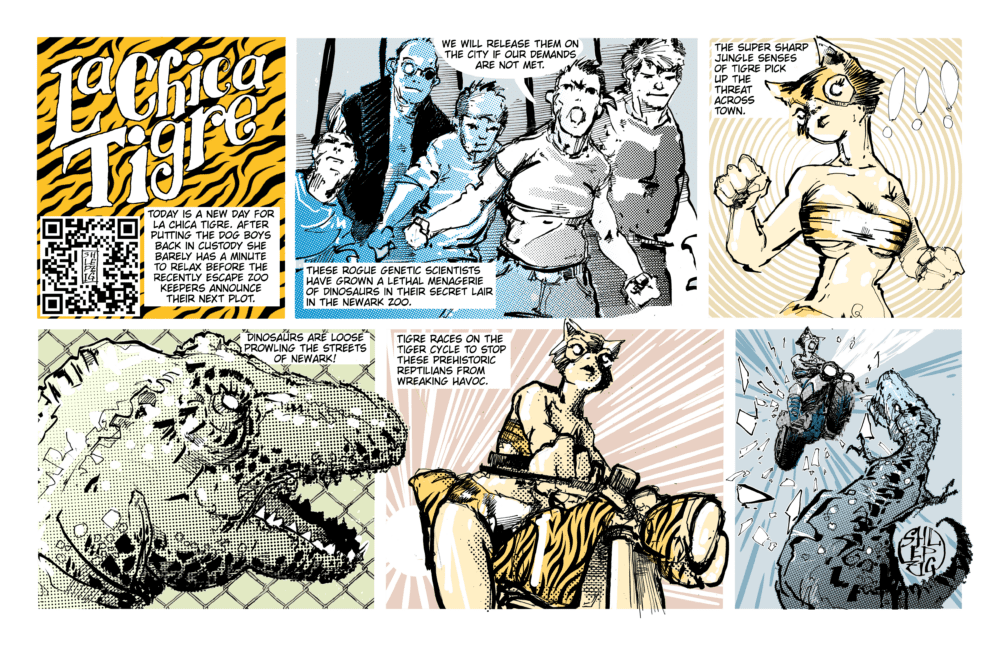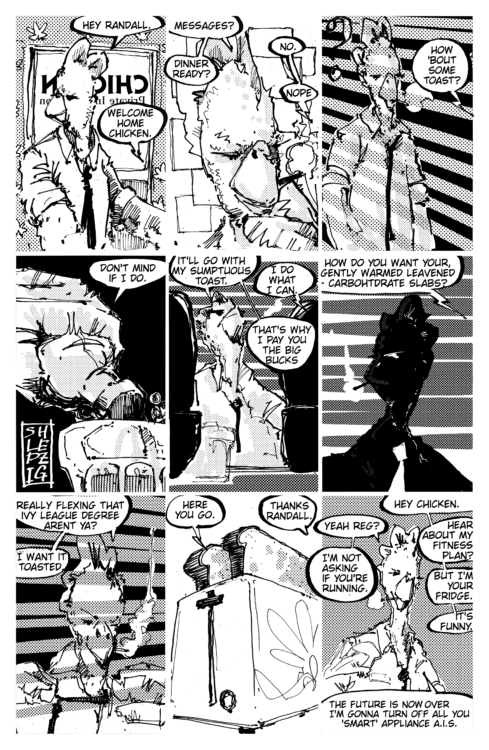Welcome to Self-Published Spotlight, a regular interview column where I will be highlighting self-published comics and the creators and small print publishers who make them.
As soon as I laid eyes on Sam Blanchard’s (aka Shlepzig) art, I was taken. Heavily stylized, flowing and clean, his art has a ton of movement and design. You don’t so much look at it, it jumps right off the page and straight into your eyes. Sam has also had a storied life in and out of comics (for example, the dude is also a swashbuckling fencer swordsman who coaches kids). Talking to Sam was a lot like ingesting his comics, full of love for the comics medium, with true artistic sensibility and the talent of delivering A LOT in a short amount of time.
Monkeys Fighting Robots: Sam what’s your comic book origin? How and when did you get into comics?
Sam Blanchard: Like pretty much everyone else, I started reading comics as soon as I could read. Normal fare, Superman, Spiderman, Peanuts… the stuff everybody read in the mid-70s. I also loved cartoons, the Fleischer Popeyes, Loony Tunes and Disney shorts. I was drawn to everything cartoony, I would run home in 3rd grade to catch Speed Racer on local channel 12 making me a weeb at an astonishingly young age. There was a FF I remember from when I was 7 or 8. The Four are kidnapped Prisoner style to Latveria where Doctor Doom has them kept in this creepy community, it must have been a Kirby issue because the weird technology and designs were intoxicating to look at. My parents were both art teachers and aspiring professional fine artists. So drawing and painting were the default activities whenever kids were over or there was just a little downtime. Maybe that’s what made me sensitive to visual narrative, maybe it changed something deep inside me. All those factors came together and by my early teen years, it was clear there was something different about me. I gravitated to D&D in the early 80s, I obsessed over the Toth-designed Herculoids and Johnny Quest, Thundarr blew my mind. I bought comics obsessively in the early to mid-80s when amazing things were happening in the medium. I discovered Heavy Metal in 1979 on the back shelf of the Magazine rack where I wasn’t supposed to look, next to the Easy Riders. Rick Veitch’s Abraxas and the Earth Man, Corben’s Den and my favorite Ranxerox. My mutant powers were somehow unleashed around high school. I would never again be like other humans, I was doomed to be a cartoonist. In 85 to 86, the year I graduated from high school, there was the indy comic boom. Previously it was just whispered legends of zines like the Freak Brothers found in head shops or behind the beaded curtains at used record stores. Now there was Cerebus and ElfQuest, creator-owned properties. AD2000 stuff coming out of Europe… stuff beyond just Marvel or DC. The turning point was the Turtles. TMNT was fantastic but that’s not its key to success, it was a balance of goofy and gritty and the art was good but not too good. You read it and were inspired to think, “I could do that”. So I started to believe. So did everybody else, when I went to the campus comic shop it was filled with TMNT imitators as well as a million others. Most of them were awful. I took a step back and thought how can I do this without making something as awful as most of this? There was a long pause.
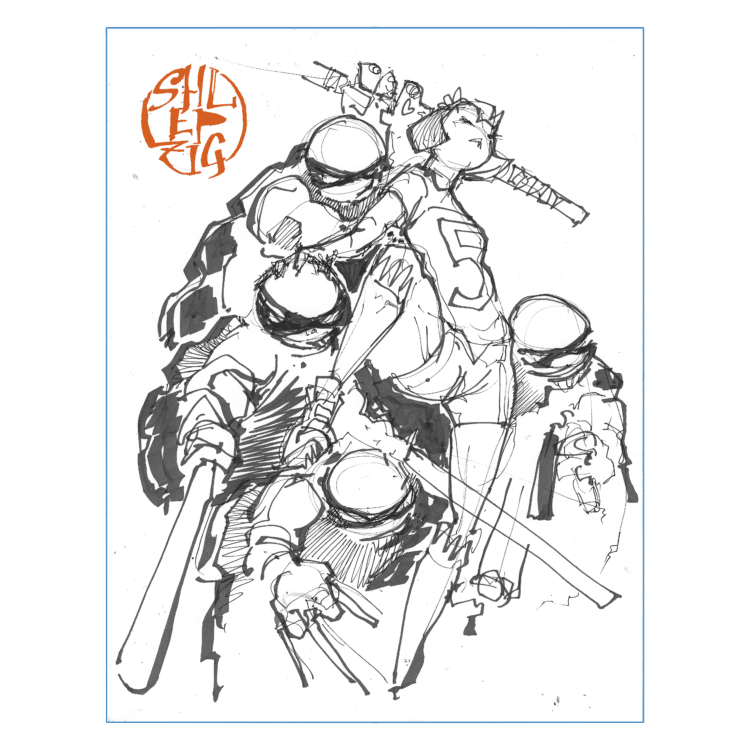
MFR: That’s a Tolkienish journey! So when did you make a conscious effort to create your own book?
SB: I checked out of the comics scene around the time I left my first college journey in 1990. I rode my motorcycle around Oregon, couch surfing, playing in the SCA and other salacious lifestyle choices. I narrowly missed becoming a tattoo artist. One thing led to another, I was studying engineering and art in Portland, Or. I was doing freelance illustration through the indy zine circles in 1993 and illustrations for the never published Great Adventure Game (aka GAG). I was doing ok but not making a ton of money when I found myself a single father to my son Bjorn. I kinda figured I should get a steady job. So I quit studying art, buckled down, moved out to the desert and got my engineering degree in another year (25 credit quarters and a Summer term). That kinda stuck for many years until the USA decided a Scooby Doo villain should be the president. I had picked up my art supplies now and again over the years but not seriously. I occasionally picked up a copy of Spider-man or Daredevil to read on the train to and from NYC every day. I kept coming back to comics, exciting stuff was happening in comics and manga through the 2000s but it never stuck for long. Now though, I needed some serious art therapy or I would just refresh the Washington Post feed to find out what president cheeto had done next… The work culture was awful, and the evil bank I worked for was going downhill (they had to pay billions of dollars in fines after the subprime fiasco) so I was pretty much left alone in my office. I could draw most of the day, answer a few emails and run the scripts I had written that mostly did my job for me. I discovered the Cartoonist Kayfabe vlog through BoingBoing (that had been running Ed’s Hip-Hop Family Tree) and started posting my art on Instagram as I started getting my chops back. I was considering making a comic again once I felt I could draw a bit now. I started doing Draw This In Your Style challenges #DTIYS and was doing them as little 4-panel strips to learn how to tell stories (in print in collection Number 1). I met James Edward Clark and Matt King (Tales To Enlighten) through Instagram. I was definitely getting more confident in my art and storytelling. The bank decided to let me go in December of 2019, and I was cool with that, they gave me a generous severance and I was ready to take on the dual life of fencing coach and cartoonist. Things were going swimmingly, I finished the high school fencing season in Feb. I opened my fencing club in the same month. I had met a bunch of makers online like Erik Klaus and was following Jamie Jones and Matt Sardo with Monkeys Fighting Robots. My plan was to go to a bunch of cons in 2020 to network and figure out the ropes. I had my first con badge and was super excited for Zapp Con, on March 20, 2020. We know how that worked out. So we were all scrambling to figure out if this was going to be a 28-day or a Mad Max scenario. I discovered Cartoonist Kayfabe Ringside Seats. Matt King was just starting work on TTE 2 while finishing up TTE 1 and asked me to do an 8-pager for him. So that was a long-term gig to do whenever (I think it took over two years to get done). Then the fateful call to arms for Image Grand Disaster to do some coloring for a story that was running late. That was it… I was locked in a small room, never coming out, drawing all day or reading comic books, and watching anime with my daughter. I was a full-fledged cartoonist now.
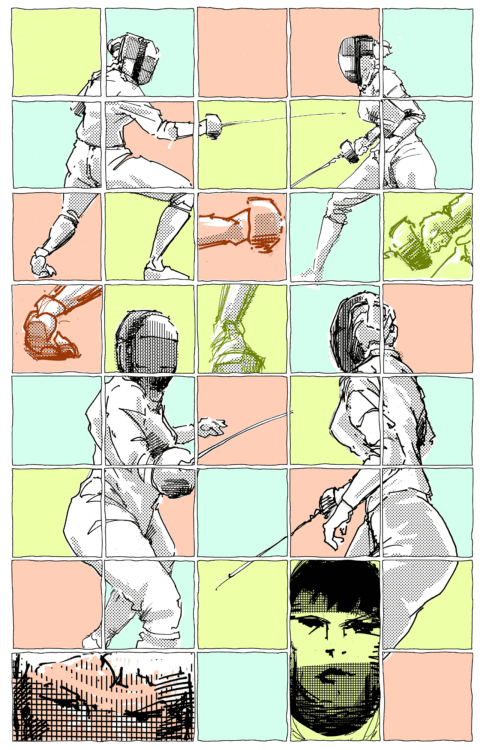
MFR: From finance to fencing to funny books! I love it!
SB: Engineering for a finance company. I was part of the global engineering team leading data center strategy.
MFR: Still makes you a man of many hats!
SB: Like Johnny two-hats!
MFR: One thing I admire about you is your speed at cartooning. Having sat with you through various zoom drawing/hanging out group sessions you have an amazing pace. And not only that, your art doesn’t suffer for it. How do you accomplish that level of speed?
SB: I draw fast for a couple of reasons, firstly I just can’t stick with a piece for too long, I get bored and lose interest, or overwork the piece. Dealing with my children’s ADHD I’m pretty sure I have undiagnosed ADD and high-functioning autism myself. So I also suspect that’s part of it. Just kinda working within the confines of my own head. Why does it work? I think I have good instincts and my first decision is probably the best one, that way I don’t fall prey to self-doubt and rework a piece until it’s just mud. It’s a philosophy I think is true for most people. I don’t think I have extraordinary instincts, I think we all intrinsically understand what works and what doesn’t. The trick is committing to that raw unedited idea without flinching. I use a phrase when I am coaching “being fully committed to a bad plan is better than half committed to a good plan”. Artistically, the idea is that we will edit ourselves out of something really innovative when we start to hold back. Not that everything comes out as pure gold, but those raw ideas are the ones that are most interesting and most honest to our true inspiration. So I just throw ink down and see what happens. It’s usually pretty interesting. I think my work gets a lot less interesting when I start to think about it too much. Of course, some of it is just not good, but I try to move on to the next thing and see what happens.
MFR: With all that in mind then, what would you say is the favorite of your works or the one that best represents you and your art?
SB: That’s a tough one. I have only been at this a couple of years so I don’t have an expansive body of work like a lot of the cartoonists I know. I feel like my skills are still growing really quickly and I am evolving as a storyteller. So the best representation of me as a storyteller is probably yet to come. I really love the book Red and the world of File 2231 in which it resides (there is more upcoming). That scratches a lot of itches for me, the sisters of our lady of extraterrestrial lament are semi-erotic, hyper-violent, supernatural nuns in retro 60s miniskirts and gogo boots fighting against sll the things that go bump in the night: over-the-top action, pulp sensibility, supernatural horror, sexy ladies and a little goofball humor. There so much more to come. If you read my 2021 Collection you get a pretty clear view of who I am, but I was just a baby cartoonist then (fundamentally, I still am). That collection is a really wide view of me, my influences, my history, my process and learning how to do cartooning. It’s a very personal project. The work I did for a Troma tribute comic (hopefully coming out soon) is really astounding (and unspeakably filthy). Certainly outside of my explicitness comfort zone but pushed me with composition and color so I learned a lot. Perhaps a turning point for me was the Cyber-Ice-Strike six pager I did for the Ringside-Thology session on Liefeld night. I solidified a couple of things for myself that are becoming signature design elements for me, borderless panels and a single color palette defined as a background color that the rest of the art sits on top of in both positive and negative space. Narratively, the character came together and the story leaves you wanting more (I am often asked when more is coming out with this character). I think I have danced around that answer sufficiently.
MFR: Can you talk about your process? Do you approach each project the same? or does it change for each? And what’s in your tool kit, both analog and digital?SB: As far as making comics it can vary depending on where my story is coming from. If I am writing myself it’s very loose. I get some plot points on paper and start drawing some images that match. I string them together on the page and act out dialog looking for those “I’ll be back” moments where the dialog clicks with the scene to bring the right nuance. When I get a script from another author I prefer to get something really loose. I want to use my storytelling instincts and style to set the pace and mood i am getting from the story. My favorite collaboration was Heavy Traffic written by Jonathan Thompson and visually compiled by me (featured in Wizerd #2). Jonathan had a set of plot points for a 16-page story about the world and we had a 6-page limit for our submission. I banged some ideas back and forth with Jonathan and trimmed it back and I think we delivered a really powerful piece. I did a great project recently with David Allen where he had already written a ‘full’ script and it was a really good story but I had a couple of issues with the pacing. We worked on a bunch of edits to get the story but never settled on the edits to the page composition I wanted. I ended up doing it twice with both layouts (it only required a couple of extra panels to be drawn – digital composition FTW). The end result is fantastic, Pepere will be in Fugitive Poems Fall release of Containment Breach #4. So i kinda roll with the punches, but really prefer an open sandbox to play in. What is called The Marvel Method is my favorite collaboration method for that reason. I feel that you’re going with an artist to tell your story because you like how they do it, let them tell your story they way they think is best. Artistically, I usually do really loose pencils on paper and follow with ink on paoer. There’s something about what I can do with a tool in my hand on actual paper i can’t achieve with digital. I use mechanical pencils with regular or blue line Iead in .5mm .9mm and 2mm sizes (mostly the bigger ones). I ink mostly with Pilot Parallel calligraphy pens and Microns but also use some manga nylon brush nibs (kuretake? maybe) and felt chisel tip pens. I’m playing with stamps as well (another inspiration borrowed from Jesse Lonergan whom I probably owe money for the ideas I have lifted from him).
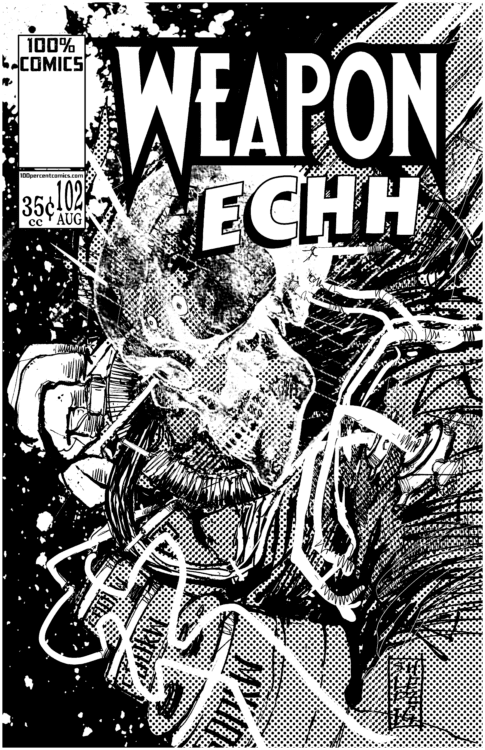
MFR: Do you have a favorite part of the process and by contrast one that you just HATE? I’d also love to hear your specific influences, both in terms of comics and any other medium or media.
SB: My favorite part is probably inking, that’s where the art comes to life. I enjoy the entire process, if I had to hand letter everything, I would hate that. I don’t hate page layout, but it is the part I find most daunting and frustrating. In part, because I collage my pages together, sometimes I don’t get the image size right and I have to trim or squish it to get it to fit the panel in the page. Or sometimes i just have to redraw a panel because I changed my mind about layout. All in all, I really enjoy the entire process, writing, drawing, lettering and pre-press editing. I’m always learning new things, so maybe ill eventually learn a process I hate.
Influences is a big one. Classic comics from the Silver Age through the 80s and the early indy scene. All the big names fit in there. Ditko, Kirby, Buscema, Byrne, Neal Adams, Perez etc Later, Sienkiewicz (New Mutants), BWS (Machine Man), Kaluta (Starstruck), Corben (general horror), Veitch (Abraxas), Moebius (Arzach, Incal), Jansen (DD), Sim (Cerebus), Eastman, Laird (TMNT). Michael Golden (Micronauts) And oddballs like Edward Gorey and Charles Addams Classic comic creators like McCay, Herge, Herriman, Schultz are also big influences. Heavily influenced by Alex Toth’s adventure cartoons from Hanna-Barbera. Illustrators/painters like Maxfield Parrish, Arthur Rackham, Gustav Dore were big inspirations from the books I read they illustrated. Story wise I love pulp lit. Robert E Howard, Edgar Rice Burroughs, Lovecraft, Poe, Hammett, Rudyard Kipling, Jack London, that whole lot. Miller really captured pulp sensibility in his seminal series from DD to DKR to Sin City, it’s all pulp tropes. I love anime and manga, the view of storytelling outside of western culture is a really fresh take. So n the anime and manga world, that’s what I was picking up in the 90s. In the post-Robotech/pre-Streaming world you could find all manner of VHS insanity and Viz was just starting to invade bookstores. Early stuff like Battle Angel Alita, Patlabor, and M66 led to the theatrical releases of Fist of The North Star, Akira and Ninja Scroll. I love all that over-the-top stuff. I moved to the east coast in ’98 the internet was changing everything, so much stuff. It was all influencing me. Post 9-11 I was minding a data center in SoHo that the company I worked for was moving out of. It was basically just me in the building for 3 months with practically nothing to do. I started drawing again for a while. Browsing the internet with the new search engine Google I discovered some incredibly influential artists, Celia Calle and through her Ashley Wood. Lately, my favorite modern manga work has been Tsutomo Nihei and his combined world of Blame, anything and everything by Masaaki Yuasa or Satoshi Kon and Pluto by Naoki Urasawa. Cowboy Bebop creator Shinichiro Watanabe also has a golden touch. Incredible stuff all around. The Gonzo Studio era is also a favorite, expansive work like the Range Murata designed Last Exile, the crazed Count of Monte Cristo adaptation, Ergo Proxy and Serial Experiments Lain and TekkonKinkreet. The abstracted designs and deeply layered stories are intoxicating. There was the dawn of Trigger studios, I adore everything out of Trigger. It’s so fluid and crazy kinetic. The opposite is the Ghibli creations. I remember relentlessly hunting down the first (terribly edited) release of VHS of Nausicaa after seeing part of it airing on channel 12. All of Miyazaki’s work has such heart. I strive for that kind of honesty in my own work. Films and such, I love all the cheesy sci-fi exploitation flicks of the 70s. Invasion of the Bee Girls is such a touchstone, but that whole era pre-Star Wars. After Star Wars everything was kinda trying to be Star Wars, but before that, you had goofy navel-gazers like Silent Running or Zardoz to Planet of the Apes. Those are my favorites. I lean into some of that sensibility in making comics. I dont think in operatic arcs but in smaller scenes in back alleys and obscure corners (like The Maxx). Same for my musical tastes, I was a goth/punk aficionado in the 80s after growing up on hippie folk music. That DIY gritty art punk scene was my favorite stuff. Basically, if it was a band that launched itself after listening to the Velvet Underground I loved it. We are the sum of our influence after all. All the parts of my history inform the art and stories I create now. Uniquely weird and a bit off-kilter. I don’t need or want my art or stories to be beautiful or objectively perfect draftsmanship but I want them to make you think about the subject or look at the medium in a new way.
MFR: Why the nome de plume Shlepzig? What’s the story behind it?
SB: That’s an interesting one. I’ve used Shlepzig as a handle since before the world wide web was part of the internet. The origin is a deep cut from Gravity’s Rainbow by Thomas Pynchon (a favorite novel of mine, I forgot to write a fourth essay on my deep love of post-modern writing…) In the story, the protagonist, Tyrone Slothrop, has to sneak across enemy lines into Nazi Germany to determine the secret payload on a V2 rocket the schwarzgerat. To do so he secures a fake ID for Max Schlepzig (who is apparently a historical reference to an actual german actor at the time, near as I can tell he was not a sympathizer). So in those days a limited amount of memory was allocated for your login ID and you were limited to 8 characters. As a result, I dropped the C as the least important letter and thus Shlepzig was established. That didn’t stop Jim Rugg from spelling it Schlepzig in his Octobriana process book with the bit of fan art I did. Shlepzig is kinda funny as it seems to trigger any latent dyslexia people may have. Invariably people get the letters mixed up one way or another. Once they get it though, they don’t forget it. That’s the story of Shlepzig, which is almost as interesting as the story of how I came to be called Sam (which isn’t really my name either).
MFR: And where can people find your work?
SB: To browse most stuff, my Instagram and Facebook accounts:@Shlepzig.comics and @Shlepzig.nsfw. There’s my Twitter @Shlepzig I have a YouTube channel @Shlepzig with tutorials. I also have a Twitch @Shlepzig. You can buy books and prints and stuff at my Etsy shop @ShlepzigIllustration Or support me on my Patreon @Shlepzig It’s all linked through my Linktree https://www.linktr.ee/Shlepzig or my website https://www.shlepzig.com My Deviant account is active again as well. Search me up on Amazon for Shlepzig or Drive Thru Comics for ebooks (not as cool as physical books) Lastly, find me at cons. I am booked for NJ CollectorFest on March 12, HeroesCon in June, and Black Label ComicCon in August. I am applying to SPX, Baltimore CC, NYCC, Rose City CC and SDCC.